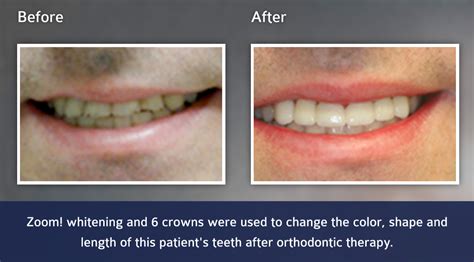What Whitens Tooth Crowns? Brighter Smile Solutions

The quest for a brighter smile has led to the development of various tooth whitening solutions, each with its own unique benefits and considerations. When it comes to tooth crowns, the approach to whitening is slightly different compared to natural teeth. Tooth crowns, being artificial, do not respond to whitening agents in the same way that natural enamel does. However, there are still several methods that can be employed to achieve a uniformly brighter smile, even with crowns.
Understanding Tooth Crowns
Tooth crowns are caps that cover the entire visible portion of a tooth, used to restore its shape, size, strength, and appearance. They can be made from a variety of materials, including ceramic, porcelain, porcelain fused to metal, and gold. The material used for a crown is selected based on the location of the tooth, the patient’s preferences, and the dentist’s recommendations.
Whitening Options for Crowns
Since crowns are made of materials that do not change color with traditional whitening treatments, the approach to whitening involves either replacing the crowns or using alternative methods to match the surrounding teeth.
Replacing the Crowns: If the crowns are old or do not match the desired whiteness, one option is to replace them. This involves removing the old crowns and taking impressions for new ones that match the shade of the whitened natural teeth. This method is the most direct way to ensure that the crowns are as white as the surrounding teeth but is also more invasive and expensive.
Veneers: For cases where the crowns are still in good condition but do not match the color of whitened natural teeth, veneers can be an option. Veneers are thin layers of porcelain placed over the front of the teeth (or crowns) to change their color and shape. This method is less invasive than replacing the crowns but still requires some preparation of the tooth surface.
Bonding: Dental bonding involves applying a tooth-colored resin to the crown to change its color. This method is less expensive than veneers or replacing the crowns but may not be as durable and can stain over time.
Internal Whitening: For crowns that have a darkening interior (due to the tooth underneath the crown), internal whitening can be an option. This involves placing a whitening agent inside the crown to lighten the tooth from the inside out. However, this method is typically used before the crown is placed and may not be applicable for existing crowns.
Preparing for Whitening with Crowns
Before undergoing any whitening procedure, especially if you have tooth crowns, it’s crucial to consult with a dentist. They can advise on the best approach based on the type of crowns you have, their condition, and the desired outcome. In some cases, whitening the natural teeth first and then adjusting the crowns accordingly might be the best strategy.
Maintenance of Whitened Crowns
Once the crowns have been whitened or replaced, maintaining their appearance is key. Regular dental hygiene practices such as brushing, flossing, and visiting the dentist for check-ups are essential. Additionally, avoiding foods and drinks that can stain teeth, such as coffee, wine, and berries, can help in preserving the whiteness of both natural teeth and crowns.
Conclusion
Achieving a brighter smile with tooth crowns requires a thoughtful approach, taking into consideration the material of the crowns, their condition, and the desired level of whiteness. By understanding the available options and consulting with a dental professional, individuals can make informed decisions about how to best enhance their smile. Whether through replacement, veneers, bonding, or internal whitening, there are solutions available for those seeking to whiten their tooth crowns and achieve a more uniform, brighter smile.
Can tooth crowns be whitened like natural teeth?
+No, tooth crowns cannot be whitened in the same way as natural teeth. Crowns are made of materials that do not respond to traditional whitening treatments, so alternative methods like replacement or veneers are considered.
How do I maintain the whiteness of my crowns after a whitening procedure?
+Maintaining the whiteness of crowns involves regular dental hygiene practices, avoiding stain-causing foods and drinks, and regular dental check-ups. It’s also important to follow any specific advice given by your dentist based on the type of whitening procedure you underwent.
Can I get veneers for my existing crowns to change their color?
+Yes, veneers can be an option for changing the color of existing crowns. However, this decision should be made in consultation with a dentist, as the condition and material of the crowns, as well as the overall health of the tooth, will be factors in determining the best course of action.

